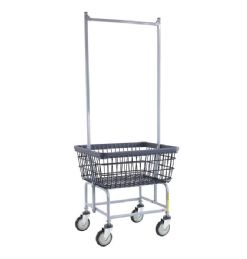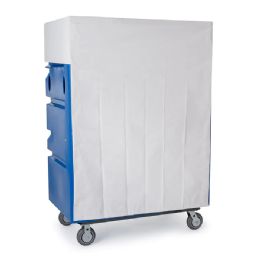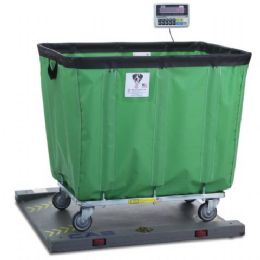






















What are Laundry Carts?
Laundry carts enable a person to move clothing to and from the laundry area with considerable ease. They may not work as well if the laundry room can only be accessed over thick carpeting, a stairway, or a rough outdoor path. They do tend to work well in areas where the laundry room is on the same floor. Those living in apartments may also find that using a laundry cart is convenient, since most carts can fit into an elevator. Commercial laundry carts are used by hotels, hospitals, care facilities and cleaning services, and are larger and more rugged in construction.
One common type of laundry cart has an open metal base with a fabric liner and wheels on the bottom, and handles at the top to pull the cart along the floor. Another type of laundry cart has a metal frame with a cloth or linen bag hanging from it, and the handle and wheels are attached to the frame. They may double as dirty clothes hampers, especially when space is limited, such as in apartments or in healthcare facilities. Commercial laundry carts have many more styles to choose from than household laundry carts. A laundry cart used for commercial cleaning may be more like a rolling multi-level wire basket shelf unit, or simply a plastic bin on wheels. A type of laundry cart with a rack for clothes hangers on the top and shelves on the bottom allows clothes to be both organized and hung up right out of the dryer.
Laundry carts that are used for commercial cleaning often have options for accessories. For example, extra wheels as well as bumper pieces and covers may be available. Covers for cleaning service carts may be made of cloth that has an elasticized edge to fit over the top of the cart. Another type of cover is made of hard plastic with hinges to allow easy access to sections of a multi-sectioned cart. Bumper pieces that fit on the corners of commercial laundry carts are made of foam to help prevent marks on the walls.
How do I Choose the Best Rolling Laundry Cart?
The best rolling laundry cart is the one that suits the particular needs of an individual or a business. To find the right one, determine where and how it will be used, then compare models that fit those needs. Think about which customer category fits best. For those who will use the cart for private and individual use, a smaller, lightweight model that can be easily transported may be the best fit. Another category includes businesses, such as hotels or hospitals that regularly launder large loads of towels and linens, and owners of coin laundry services that provide complimentary carts to customers.
Consider the exact functions the rolling laundry cart requires in order to perform. For example, if the defined need is to move clothes from the washing machine to the dryer, a simple cart with one or two compartments may be best. Or, if the application requires transporting clothes as well as laundry accessories, such as bleach, detergent, and fabric softener, a cart with compartments as well as shelves or racks would be helpful. This type additionally works well as a rolling cart at home, or as an organizational tool for the laundry room. Many rolling laundry carts are made with hanger bars for hanging clothes that wrinkle quickly, can’t be dried in a machine, or are ready to be put back into the closet.
Rolling laundry carts can also come in a variety of styles. Since they have wheels, those with wheels that turn in all directions are the easiest to move around. Some cart wheels are fixed with locking mechanisms so they stay in place when they are not in use. Different and more durable materials are used for manufacturing or industrial laundry carts. Depending on the needs of the facility, they can be made of fabric, metal, plastic, or a combination. Choosing a cart durable enough to withstand frequent and repeated use is important.
How do I Choose the Best Folding Laundry Cart?
A folding laundry cart folds flat for storage, so it takes up a fraction of the space of a traditional laundry cart. When choosing a cart, evaluate the specific and individualized laundry needs to determine the size, shape and material that will work best. Some are also available in a wide range of colors to blend with any facility’s décor. The first thing to evaluate is the size of the folded cart, since that is the main reason for choosing a folding laundry cart. Choose a cart that will fit into the designated storage space when it is folded. Determining how easily the cart opens and closes is also an important factor. Most are designed to allow them to pop open quickly for use, then collapse simply for storage when not in use.
Folding laundry carts can be short or tall, round or rectangular, and each shape is available in different sizes. Larger carts can handle heavy, large loads of laundry while smaller carts are good for light loads. Choose the type that best suits the individual’s or facility’s particular needs. The shape that works best should be considered. A tall tube-shaped or rectangular cart is easy to move around, but will not fit upright in a car trunk when full of laundry. Short, rectangular carts are closer to the ground, making the removal of clothing and linens from a dryer an easier process. They can also fit better into a car trunk for transporting purposes.
Mesh and nylon are the two most common materials used for a folding laundry cart, since they are lightweight, yet sturdy enough to handle carrying laundry. Both mesh and nylon dry more quickly, which also helps in preventing mold and mildew.
Rehabmart is proud to carry a variety of superior quality laundry carts from such esteemed and experienced vendors as R&B Wire Company, MJM International, IPU, Clinton Industries, Luxor Furniture and Mabis.
Hulet Smith, OT
Rehabmart Co-Founder & CEO
lb